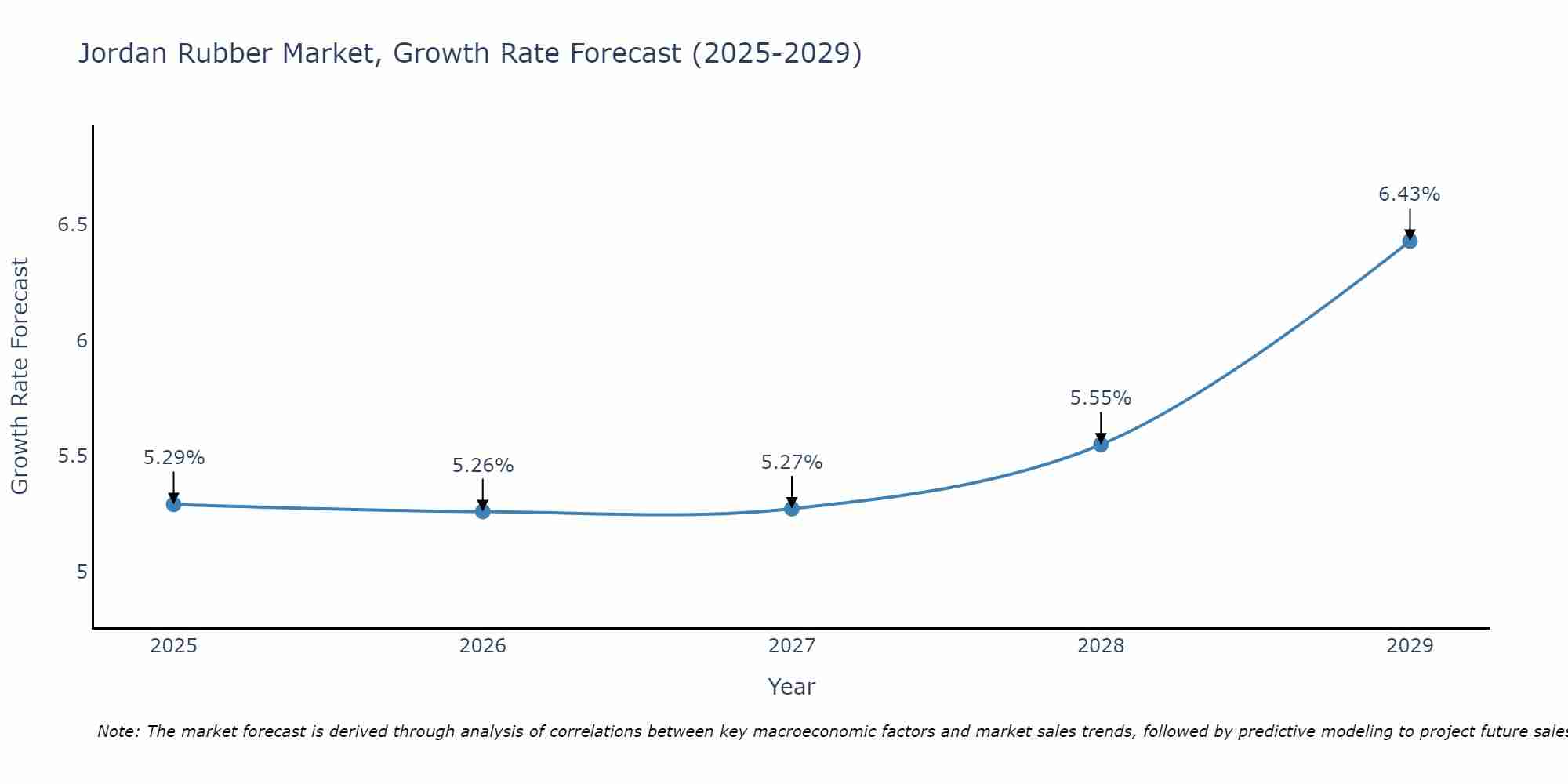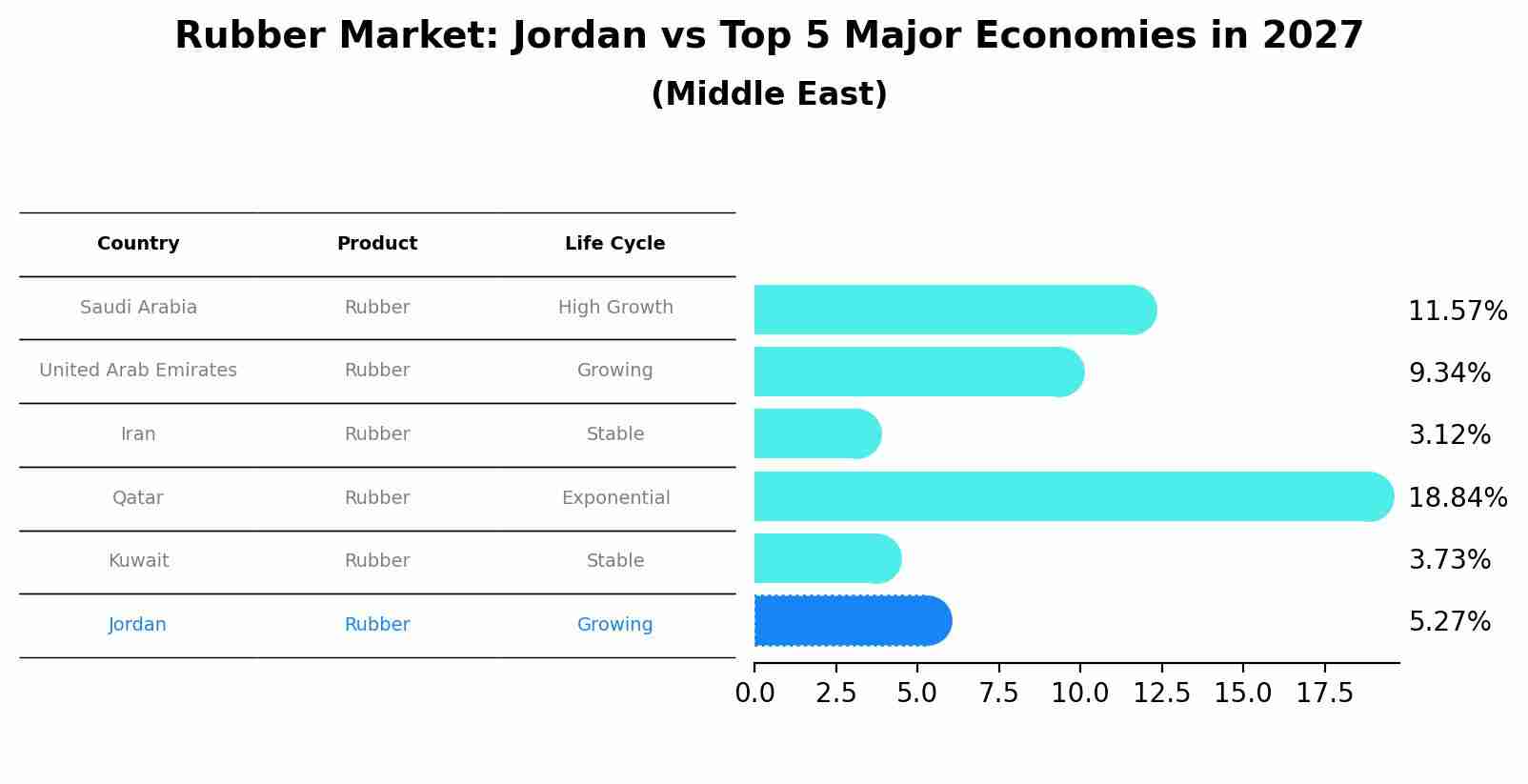Jordan Rubber Market | Analysis, Companies, Growth, Size, Trends, COVID-19 IMPACT, Industry, Share, Revenue, Value, Forecast & Outlook
| Product Code: ETC172445 | Publication Date: Jan 2022 | Updated Date: Jun 2025 | Product Type: Market Research Report | |
| Publisher: 6Wresearch | Author: Vasudha | No. of Pages: 70 | No. of Figures: 35 | No. of Tables: 5 |
Jordan Rubber Market Size Growth Rate
The Jordan Rubber Market is projected to witness mixed growth rate patterns during 2025 to 2029. From 5.29% in 2025, the growth rate steadily ascends to 6.43% in 2029.

Rubber Market: Jordan vs Top 5 Major Economies in 2027 (Middle East)
By 2027, the Rubber market in Jordan is anticipated to reach a growth rate of 5.27%, as part of an increasingly competitive Middle East region, where Saudi Arabia remains at the forefront, supported by United Arab Emirates, Iran, Qatar and Kuwait, driving innovations and market adoption across sectors.

Jordan Rubber Market Overview
The Jordan Rubber Market is characterized by steady growth driven by increasing demand from various industries such as automotive, construction, and healthcare. Jordan has a well-established rubber industry with a focus on producing high-quality natural rubber and rubber products. The country benefits from a favorable climate for rubber cultivation, leading to a steady supply of raw materials. Additionally, Jordan`s strategic location provides easy access to regional and international markets, enhancing export opportunities for rubber products. The market is competitive, with key players focusing on innovation, product diversification, and sustainability practices to maintain a competitive edge. Overall, the Jordan Rubber Market is poised for continued growth, supported by strong domestic demand and export potential.
Jordan Rubber Market Trends
The Jordan rubber market is currently experiencing a trend towards sustainable and eco-friendly rubber production. With increasing consumer awareness and demand for environmentally responsible products, rubber producers in Jordan are focusing on sustainable practices such as using natural rubber sources, reducing water and energy consumption, and implementing recycling and waste management initiatives. Additionally, there is a growing emphasis on product innovation and development of high-performance rubber materials for various industries including automotive, construction, and healthcare. The market is also witnessing an increased adoption of technology and automation in rubber manufacturing processes to improve efficiency and quality. Overall, the Jordan rubber market is moving towards a more sustainable and innovative direction to meet the evolving needs of both consumers and industries.
Jordan Rubber Market Challenges
The Jordan Rubber Market faces several challenges, including fluctuations in raw material prices, competition from low-cost imports, and limited access to advanced technologies. The industry also struggles with inconsistent quality standards, which can impact the reputation of Jordanian rubber products in the global market. Additionally, the lack of skilled labor and a fragmented market structure further hinder the growth and competitiveness of the sector. To overcome these challenges, industry players in the Jordan Rubber Market need to focus on enhancing product quality, investing in technology upgrades, and implementing efficient supply chain management practices to remain competitive both domestically and internationally.
Jordan Rubber Market Investment Opportunities
Investment opportunities in the Jordan Rubber Market include potential growth in the automotive industry, which is a major consumer of rubber products such as tires and seals. Additionally, the construction sector in Jordan presents opportunities for rubber-based materials for infrastructure development and building projects. With increasing awareness and demand for sustainable and eco-friendly products, there is also potential for investment in the production of recycled rubber products. Furthermore, advancements in technology and innovation in the rubber industry can create opportunities for investing in research and development of new rubber compounds and applications. Overall, the Jordan Rubber Market offers various avenues for investment, particularly in sectors that are poised for growth and development in the coming years.
Jordan Rubber Market Government Policy
The Jordan Rubber Market is influenced by government policies aimed at promoting domestic production and enhancing competitiveness in the global market. The government provides support to local rubber producers through subsidies, tax incentives, and infrastructure development to boost production capacity and quality standards. Additionally, trade policies focus on reducing import tariffs on raw materials and machinery used in rubber production to lower production costs and enhance market competitiveness. Regulatory measures are also in place to ensure compliance with quality standards and environmental regulations to maintain the sustainability of the rubber industry in Jordan. Overall, government policies in Jordan aim to create a conducive environment for the growth and development of the rubber market while ensuring compliance with international trade standards and environmental sustainability practices.
Jordan Rubber Market Future Outlook
The future outlook for the Jordan Rubber Market appears promising due to several factors. Economic growth in Jordan is expected to drive demand for rubber products across various industries such as automotive, construction, and healthcare. Additionally, the government`s focus on infrastructure development and industrialization is likely to increase the need for rubber-based materials. Technological advancements in rubber manufacturing processes and the growing trend towards sustainable and eco-friendly products are also expected to influence the market positively. However, challenges such as fluctuating raw material prices and intense competition from global suppliers may impact market growth. Overall, with the right strategies in place to address these challenges and capitalize on opportunities, the Jordan Rubber Market is poised for steady expansion in the coming years.
Key Highlights of the Report:
- Jordan Rubber Market Outlook
- Market Size of Jordan Rubber Market, 2021
- Forecast of Jordan Rubber Market, 2031
- Historical Data and Forecast of Jordan Rubber Revenues & Volume for the Period 2018 - 2031
- Jordan Rubber Market Trend Evolution
- Jordan Rubber Market Drivers and Challenges
- Jordan Rubber Price Trends
- Jordan Rubber Porter's Five Forces
- Jordan Rubber Industry Life Cycle
- Historical Data and Forecast of Jordan Rubber Market Revenues & Volume By Type for the Period 2018 - 2031
- Historical Data and Forecast of Jordan Rubber Market Revenues & Volume By Natural for the Period 2018 - 2031
- Historical Data and Forecast of Jordan Rubber Market Revenues & Volume By Synthetic for the Period 2018 - 2031
- Historical Data and Forecast of Jordan Rubber Market Revenues & Volume By Application for the Period 2018 - 2031
- Historical Data and Forecast of Jordan Rubber Market Revenues & Volume By Tire for the Period 2018 - 2031
- Historical Data and Forecast of Jordan Rubber Market Revenues & Volume By Non-Tire Automotive for the Period 2018 - 2031
- Historical Data and Forecast of Jordan Rubber Market Revenues & Volume By Footwear for the Period 2018 - 2031
- Historical Data and Forecast of Jordan Rubber Market Revenues & Volume By Industrial Goods for the Period 2018 - 2031
- Historical Data and Forecast of Jordan Rubber Market Revenues & Volume By Others for the Period 2018 - 2031
- Jordan Rubber Import Export Trade Statistics
- Market Opportunity Assessment By Type
- Market Opportunity Assessment By Application
- Jordan Rubber Top Companies Market Share
- Jordan Rubber Competitive Benchmarking By Technical and Operational Parameters
- Jordan Rubber Company Profiles
- Jordan Rubber Key Strategic Recommendations
Frequently Asked Questions About the Market Study (FAQs):
1 Executive Summary |
2 Introduction |
2.1 Key Highlights of the Report |
2.2 Report Description |
2.3 Market Scope & Segmentation |
2.4 Research Methodology |
2.5 Assumptions |
3 Jordan Rubber Market Overview |
3.1 Jordan Country Macro Economic Indicators |
3.2 Jordan Rubber Market Revenues & Volume, 2021 & 2031F |
3.3 Jordan Rubber Market - Industry Life Cycle |
3.4 Jordan Rubber Market - Porter's Five Forces |
3.5 Jordan Rubber Market Revenues & Volume Share, By Type, 2021 & 2031F |
3.6 Jordan Rubber Market Revenues & Volume Share, By Application, 2021 & 2031F |
4 Jordan Rubber Market Dynamics |
4.1 Impact Analysis |
4.2 Market Drivers |
4.3 Market Restraints |
5 Jordan Rubber Market Trends |
6 Jordan Rubber Market, By Types |
6.1 Jordan Rubber Market, By Type |
6.1.1 Overview and Analysis |
6.1.2 Jordan Rubber Market Revenues & Volume, By Type, 2021-2031F |
6.1.3 Jordan Rubber Market Revenues & Volume, By Natural, 2021-2031F |
6.1.4 Jordan Rubber Market Revenues & Volume, By Synthetic, 2021-2031F |
6.2 Jordan Rubber Market, By Application |
6.2.1 Overview and Analysis |
6.2.2 Jordan Rubber Market Revenues & Volume, By Tire, 2021-2031F |
6.2.3 Jordan Rubber Market Revenues & Volume, By Non-Tire Automotive, 2021-2031F |
6.2.4 Jordan Rubber Market Revenues & Volume, By Footwear, 2021-2031F |
6.2.5 Jordan Rubber Market Revenues & Volume, By Industrial Goods, 2021-2031F |
6.2.6 Jordan Rubber Market Revenues & Volume, By Others, 2021-2031F |
7 Jordan Rubber Market Import-Export Trade Statistics |
7.1 Jordan Rubber Market Export to Major Countries |
7.2 Jordan Rubber Market Imports from Major Countries |
8 Jordan Rubber Market Key Performance Indicators |
9 Jordan Rubber Market - Opportunity Assessment |
9.1 Jordan Rubber Market Opportunity Assessment, By Type, 2021 & 2031F |
9.2 Jordan Rubber Market Opportunity Assessment, By Application, 2021 & 2031F |
10 Jordan Rubber Market - Competitive Landscape |
10.1 Jordan Rubber Market Revenue Share, By Companies, 2021 |
10.2 Jordan Rubber Market Competitive Benchmarking, By Operating and Technical Parameters |
11 Company Profiles |
12 Recommendations |
13 Disclaimer |
- Single User License$ 1,995
- Department License$ 2,400
- Site License$ 3,120
- Global License$ 3,795
Search
Thought Leadership and Analyst Meet
Our Clients
Related Reports
- Germany Breakfast Food Market (2026-2032) | Industry, Share, Growth, Size, Companies, Value, Analysis, Revenue, Trends, Forecast & Outlook
- Australia Briquette Market (2025-2031) | Growth, Size, Revenue, Forecast, Analysis, Trends, Value, Share, Industry & Companies
- Vietnam System Integrator Market (2025-2031) | Size, Companies, Analysis, Industry, Value, Forecast, Growth, Trends, Revenue & Share
- ASEAN and Thailand Brain Health Supplements Market (2025-2031) | Strategy, Consumer Insights, Analysis, Investment Trends, Opportunities, Growth, Size, Share, Industry, Revenue, Segments, Value, Segmentation, Supply, Forecast, Restraints, Outlook, Competition, Drivers, Trends, Demand, Pricing Analysis, Competitive, Strategic Insights, Companies, Challenges
- ASEAN Bearings Market (2025-2031) | Strategy, Consumer Insights, Analysis, Investment Trends, Opportunities, Growth, Size, Share, Industry, Revenue, Segments, Value, Segmentation, Supply, Forecast, Restraints, Outlook, Competition, Drivers, Trends, Demand, Pricing Analysis, Competitive, Strategic Insights, Companies, Challenges
- Europe Flooring Market (2025-2031) | Outlook, Share, Industry, Trends, Forecast, Companies, Revenue, Size, Analysis, Growth & Value
- Saudi Arabia Manlift Market (2025-2031) | Outlook, Size, Growth, Trends, Companies, Industry, Revenue, Value, Share, Forecast & Analysis
- Uganda Excavator, Crane, and Wheel Loaders Market (2025-2031) | Strategy, Consumer Insights, Analysis, Investment Trends, Opportunities, Growth, Size, Share, Industry, Revenue, Segments, Value, Segmentation, Supply, Forecast, Restraints, Outlook, Competition, Drivers, Trends, Demand, Pricing Analysis, Competitive, Strategic Insights, Companies, Challenges
- Rwanda Excavator, Crane, and Wheel Loaders Market (2025-2031) | Strategy, Consumer Insights, Analysis, Investment Trends, Opportunities, Growth, Size, Share, Industry, Revenue, Segments, Value, Segmentation, Supply, Forecast, Restraints, Outlook, Competition, Drivers, Trends, Demand, Pricing Analysis, Competitive, Strategic Insights, Companies, Challenges
- Kenya Excavator, Crane, and Wheel Loaders Market (2025-2031) | Strategy, Consumer Insights, Analysis, Investment Trends, Opportunities, Growth, Size, Share, Industry, Revenue, Segments, Value, Segmentation, Supply, Forecast, Restraints, Outlook, Competition, Drivers, Trends, Demand, Pricing Analysis, Competitive, Strategic Insights, Companies, Challenges
Industry Events and Analyst Meet
Whitepaper
- Middle East & Africa Commercial Security Market Click here to view more.
- Middle East & Africa Fire Safety Systems & Equipment Market Click here to view more.
- GCC Drone Market Click here to view more.
- Middle East Lighting Fixture Market Click here to view more.
- GCC Physical & Perimeter Security Market Click here to view more.
6WResearch In News
- Doha a strategic location for EV manufacturing hub: IPA Qatar
- Demand for luxury TVs surging in the GCC, says Samsung
- Empowering Growth: The Thriving Journey of Bangladesh’s Cable Industry
- Demand for luxury TVs surging in the GCC, says Samsung
- Video call with a traditional healer? Once unthinkable, it’s now common in South Africa
- Intelligent Buildings To Smooth GCC’s Path To Net Zero


















